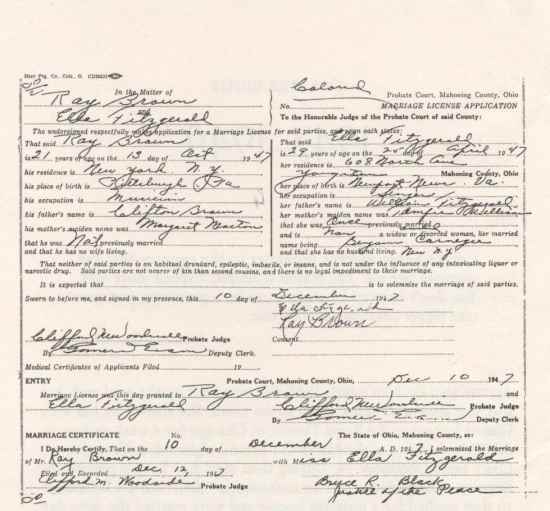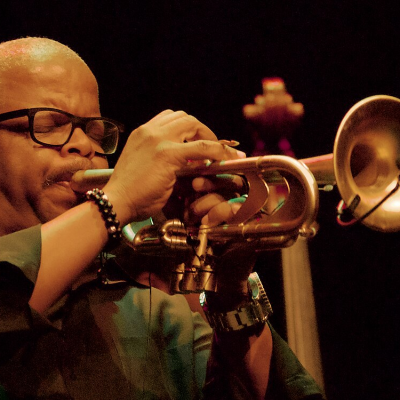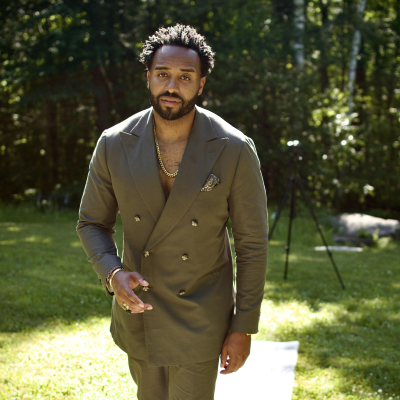_____
In November, 1946, at the height of his popularity, Dizzy Gillespie took his big band out on the road, and in 1947 hired Ella Fitzgerald to tour the South. According to Ella’s biographer Stuart Nicholson, she had been added to this tour in response to Gillespie’s Hepsations tour in 1945, whose groundbreaking sound “had confused and confounded the southerners,” and because Ella could “create balance after the unrelieved diet of bop…The Gillespie band saw Ella as a former swing era star, light-years removed from what they were doing, a palliative to help their music go down with the public.”
Even with Ella, however, things could be challenging. The audience would “listen, stand around and applaud,” band member Howard Johnson said,” and try and pretend they dug it. I think they appreciated the artistry of Dizzy because marvelous technique was involved. But the music wasn’t really danceable.” Tenor saxophonist James Moody said the southern audience “would look up at the bandstand as if we were nuts. One time down South this guy was looking up, and he said, ‘Where’s Ella Fitzgerald? He was mad because he didn’t see Ella.”
Pianist John Lewis spent time in the band and said, according to Nicholson, that Ella “lent Dizzy her prestige…My appreciation for Ella wasn’t as great as it should have been, although after Dizzy kept pointing it out to me every night, I got the message!” The tour also served Ella, as it allowed her to “embrace [bop] wholeheartedly. When the tour started, she was an ‘outsider,’; when it finished, she had earned the approbation of her peers, she was ‘in.’”
“For Ella,” Nicholson wrote, “whose remarkable ear intuitively reacted to the subtle chord voicings, bop represented a challenge that linked her vocal technique to her powerful, propulsive rhythmic gift…[Bop musicians] sped through bar lines with a gusto that left swing era players gasping, often taking flight in cascades of sixteenth notes that made the music appear to speed by twice as fast. Bop knocked listeners out of their diatonic comfort zones. It demanded the active participation of the audience, which had to listen to understand what was going on. Jazz was consciously moving out of the realms of popular entertainment and demanding acceptance as a true art form in its own right.”
“Such a stylistic Rubicon was too wide for the swing musicians to cross,” Nicholson opines;” they could only look on as bebop took over, establishing itself as the preeminent style in jazz by the end of the 1940s. For the swing era players, many then still young and at the height of their powers, such as Benny Goodman, Roy Eldridge, and Buck Clayton, it was a bitter pill to discover that almost overnight their style had become old hat. Some, like Coleman Hawkins and Don Byas, almost succeeded in adapting to bop, but only one – Ella Fitzgerald – successfully made the transition. In a music dominated by males, this was no mean achievement.”
The tour was also gratifying to Ella on a personal level. While she loved dancing in clubs – especially with Dizzy – he was married and off limits romantically, which opened the door for a relationship with the band’s bassist Ray Brown, who she eventually married on December 10, 1947. Ella fudged on her marriage certificate (shown below), citing her birth year as 1918 rather than 1917, possibly so both she and Brown — nine years her junior — would be in their twenties at the time of their marriage.
Their marriage, of course, didn’t last. Challenged by conflicting career paths, Nicholson writes that “tension within their relationship were never far from the surface. Ella felt strongly that both professionally and personally, Ray’s position should be at her side. Ray felt equally strongly that he should pursue his career with Oscar Peterson,” a choice that ultimately contributed to the couple’s Mexican divorce in August, 1953.

Ella sings “Lover Man,” a 1947 recording with Dizzy Gillespie’s big band



































Ella was so intuitively a musician that even when she was very young, she listened to a song twice and knew it. Her voice remained ever young, fun, and full of the joy of her love of music
Ella was so intuitively a musician that even when she was very young, she listened to a song twice and knew it. Her voice remained ever young, fun, and full of the joy of her love of music